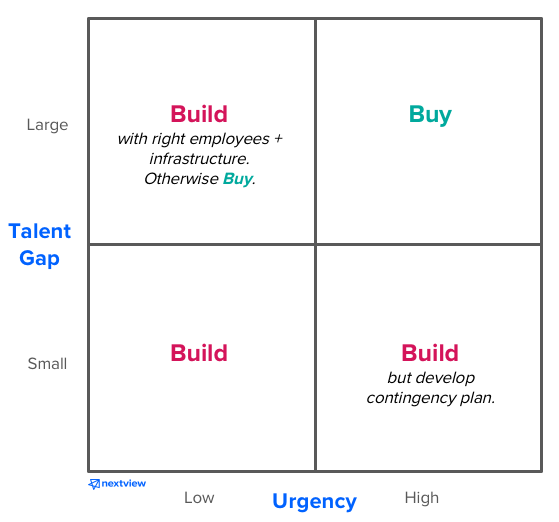
Melody Koh
Talent is arguably the most important factor for any company’s success. It’s especially important to have the right people in place at the earliest stage of the company — as your company grows, the impact of these early-stage hires grows, too.
You also have to be realistic. While you may want to hire an industry expert early on, you may be constrained by budget, time, or brand cachet (or all three). But there are also drawbacks to promoting a more junior current team member with the expectation that they grow into the role.
The decision to Build (develop internally) or Buy (hire ready-to-go externally) talent is one founders and operators struggle with at every stage of a company’s journey:
- Seed/Series A Stage: I need to make the first [insert function] hire. How senior do I go?
- Growth Stage:I need to level up execution to “best in class.” Do I have the people for that?
- Maturing Stage: I need people who can thrive in a different environment — increased complexity and size requires a different way of collaborating and communicating.
There isn’t a straightforward answer to the Build vs. Buy question. Based on my experience building Blue Apron’s product team from scratch as well as talking with many startup leaders, here’s a framework you can use to make this decision a bit easier.
The Build vs. Buy Framework for Making Hiring Decisions
What makes this decision so tricky is that there isn’t one correct answer. By opting for Buying all the time, you risk having a lot of “organ rejects” and sending a signal that the company doesn’t value people development. But opting for Building all the time can be risky in its own right. A manager’s time invested in developing the talent might not translate into guaranteed success (and the output the organization needs).
At Blue Apron, I developed a framework to help me make this decision. (In growing our team to 35 people across multiple product and analytics functions in 3.5 years, I encountered this dilemma often.) This framework breaks down the hiring decision into two components: Urgency and Talent Gap.

Urgency: The time you have until having the skill set is critical
Usually the need for talent is triggered when the company needs something accomplished and you realize you don’t have the skill set (and/or bandwidth) required to do so.
To identify where you really are on the Urgency spectrum, ask yourself the following questions (and answer honestly):
- How much time do we have?
- What’s the opportunity cost of not getting someone in place who has that skill set?
It is tempting to say that all talent needs are urgent, but when you force yourself to prioritize and visualize the alternative without such person, you will be able to better see Build opportunities.
There is one other dimension of urgency that is often neglected but critical: institutional knowledge (e.g. people, systems, historical key decisions). For a given role, the more critical such institutional knowledge is, the costlier it is to pursue the Buy strategy. An external hire would not be able to impact the business for X months while she spends time ramping up.
Talent Gap: The current skills vs. best alternative
When evaluating the talent gap for the purpose of assessing Build vs. Buy options, you should consider skill/experience that currently exists within the organization vs. the best alternative.
There’s a bit of a subtlety here because your best alternative might not be ideal, especially if you’re an early stage startup. There are many reasons why that could be the case:
- The type of talent you can realistically attract given the company’s stage
- The scope of the role (senior talent often won’t want to join if the scope is too small)
- The depth of the local talent pool
It’s important to focus on the output you need as a company and critically examine the assumptions around what you need to get there. One mistake people make is getting hung up on “years of experience.” The number of years often mean much less than the substance of the experience itself (e.g. breadth and depth of product experience, types and volumes of product shipped and their impact on the business).
Sometimes you might find that not everything is available to Buy even if you’re willing to pay (e.g. unique skill set that’s very specific to the organization such as fluency in both product management and fulfillment/operations). You should always set a high bar for talent, but you should also be realistic.
Applying the Build vs. Buy Hiring Framework
“Talent Arbitrage” is how you win in the early stage.
When you’re an early-stage startup, it is extremely difficult to compete with others for talent — you have neither the brand nor the cash. One of the best strategies to overcome this is to bias towards Building whenever makes sense.
It’s much easier to attract star players before they have officially “made it” with the proven track records and senior titles.
Supporting infrastructure is key to Building.
If you pursue the Build strategy, make sure you have the supporting infrastructure to properly set this person up for success.
Does her manager have the ability and bandwidth to provide coaching and guidance around the aspects of the Talent Gap? Is her performance expectation properly managed across the organization? Before the Talent Gap is fully closed, can the company “get by” without compromising on critical business milestones?
Iterate your org design as you assemble your team.
It is always a good practice to approach org design as a blank canvas. The ideal structure for the company should be independent of the people on your team.
While you have to adjust based on the reality of the talent landscape, you should proactively manage the org structure as it evolves. As the company scales, ask yourself this frequently:
Am I leaving room for my star employees to grow? Am I providing them with a fulfilling career path?
If the answers are no, you will risk losing the options to Build later when that strategy could be the better decision for the company. For your startup to be successful, you need to balance filling short-term talent gaps with providing long-term career growth.

